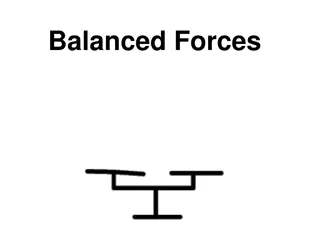Understanding the Role of Center of Gravity and Levers in Object Balance
Explore concepts of center of gravity, stability, and equilibrium in objects through investigations on balancing techniques and finding the center of gravity of irregular shapes. Discover how levers and turning forces affect object balance and design for stability.
Download Presentation

Please find below an Image/Link to download the presentation.
The content on the website is provided AS IS for your information and personal use only. It may not be sold, licensed, or shared on other websites without obtaining consent from the author. Download presentation by click this link. If you encounter any issues during the download, it is possible that the publisher has removed the file from their server.
E N D
Presentation Transcript
At the end of this unit you should: 1. Be able to find the centre of gravity of an object. 2. Be able to investigate the role of the centre of gravity in a design for stability and equilibrium. 3. Be able to investigate the law of the lever. 4. Be able to give everyday applications of levers.
balance fulcrum centre of gravity lever equilibrium moment
LIGHTBULB QUESTION A turning force is a force created by something moving in a turning motion. The general idea is that if an object is able to rotate about a fixed point, it causes a turning motion. Examples include a seesaw, door handle, wheel barrow, etc.
Investigation 12.03.01: Balancing an object Equipment: Objects as listed in Table 12.03.01 Instruction: 1. Students should work in pairs. 2. Using Table 12.03.01, try to balance each of the objects, using your finger, a pen, a table, etc. 3. Note the balancing point of the object once that object is successfully balanced.
Investigation 12.03.01: Balancing an object Table of Results:
1. Comment on your observations. It should have been possible to balance most of the objects listed; the rest won t have balanced because of their shape and/or contents, e.g. the bottle of water will be difficult to balance because the liquid is constantly moving around, thus shifting the centre of gravity.
2. Was the centre of gravity always in the centre of the object? Not always.
3. Did you find the centre of gravity of the irregularly shaped object? If so, how? The following is a possible method: 1. Punch a hole near the edge of the cut-out cardboard piece and hang it from a nail. 2. Hang the plumb line from the nail in front of the cardboard. 3. Use a pencil to draw a line down the cardboard where the thread touches. This marks your centre line from that hanging point. 4. Repeat Step 2 and 5 in two other places on the cardboard. 5. Remove the cardboard from the nail and balance on the tip of the pencil. You should know where to balance because it will be where all of the pencil plumb lines intersect, finding the centre for you.
Balance: When the upward and downward forces are equal, the object is balanced.
Draw the stable, neutral and unstable stages of equilibrium of the three objects as seen in Fig. 12.03.03: (i) Wine glass Stable Neutral Unstable
Draw the stable, neutral and unstable stages of equilibrium of the three objects as seen in Fig. 12.03.03: (ii) Thumbtack Stable Neutral Unstable
Draw the stable, neutral and unstable stages of equilibrium of the three objects as seen in Fig. 12.03.03: (iii) Football Neutral
(a) Why are passengers not allowed stand up on the upper deck of a double decker bus (unless they are getting off)? Because the passengers are further away from the fulcrum of the bus, they experience a much greater force when the driver is turning, and this could lead to serious injury should a person fall.
(b) Which is more stable: (i) A bus with its engine at the front (ii) A bus with its engine under the floor (iii) A bus with its engine at the back? A bus with its engine at the back is more stable, as this means the bottom floor of the bus is flatter and therefore lower to the ground, which makes the bus more stable.
(c) Why are double decker buses stable even at speed around corners? They have a low centre of gravity.
Fulcrum: The point of rotation. Lever: A rigid body which rotates around the fulcrum. Lever Fulcrum
Investigation 12.03.02: The law of the lever Equipment: Newton weights, metre stick, retort stand, short length of string to loop around metre stick and tie to retort stand, 2 4 paper clips. Instructions: 1. Hang a metre stick from the 50 cm mark using the piece of string. Ensure the metre stick is balanced. 2. Attach newton weights with the paper clips and adjust their positions until the metre stick balances. 3. Note the positions and forces of the weights.
1. How did you ensure this was a fair test? The metre stick was balanced and not hanging to one side.
2. Did you notice any patterns in your data? If the same weight was used, they balanced at the same distance from the fulcrum. If one was twice as heavy as the other, it balanced at half the distance of the lighter one.
3. Draw a table with two columns. One column is to note: Weight multiplied by distance from fulcrum of one weight; the other column is to note: Weight multiplied by distance from fulcrum of the other weight. Can you see any pattern forming now? Distance from the fulcrum Weight 1 Weight (10 N) multiplied by distance from the fulcrum Distance from fulcrum Weight 2 Weight (15 N) multiplied by distance from the fulcrum 0.05 m 0.5 Nm 0.03 m 0.5 Nm 0.10 m 1 Nm 0.5 m 1 Nm 0.15 m 1.5 Nm 0.75 m 1.5 Nm 0.20 m 2 Nm 0.10 m 2 Nm
4. What does this pattern tell you about balancing the metre stick? That the force x distance from the fulcrum gives us a turning force, which is what we are balancing out on the other side.
5. Can you make a mathematical formula for what you have found? Force x distance = moments.
6. Draw a diagram for each set of the measurements you took. Label which side caused the ruler to move anticlockwise and which side cause the ruler to move clockwise. Diagrams should look similar to this. The two forces causing clockwise moments are 10 N and 15 N. The anticlockwise moments are 4 N and 10.2 N.
Copy and Complete In this unit I learned that the centre of gravity is the point at which the mass appears to act. This means I can balance an object at this point. For an object to balance the forces up must equal the forces down. I also learned that there are three states of equilibrium: stable, neutral and unstable. For an object to be stable it must have a wide base and a low centre of gravity. Finally, I learned that a lever is a rigid body and that the fulcrum is the point of rotation of this body.
1. What is the moment of a force? Force x distance.
2. Calculate the moment when a force of 5 N is placed 1 m from the fulcrum. 5 N x 1 m = 5 Nm
3. A door handle experience a moment of 5 Nm when the lever is rotated 20 cm from the fulcrum. What force is exerted on the door handle? Convert 20 cm to metres = 0.20 m 5/0.2 = 25 N
4. Fig. 12.03.10 shows a metre stick suspended from its centre of gravity. A force of X N acts on the stick at the 20 cm mark and a force of 4 N acts on the stick at the 70 cm mark. The metre stick is balanced horizontally. Calculate force F. (JC HL 2013) LHS: 4 N x 0.3 m = 1.2Nm RHS: F N x 0.2 m = 0.2FNm LHS = RHS (because it is balanced) 1.2 = 0.2F 1.2/0.2 = F F = 6N
5. Give one everyday application of levers. (JC HL 2013) Door handles; wheel barrows.
6. The door handle in Fig. 12.03.11 is an application of a lever. The labels and arrows show three points. Which of the points A, B and C, represent: (i) the fulcrum (turning point)? A.
6. The door handle in Fig. 12.03.11 is an application of a lever. The labels and arrows show three points. Which of the points A, B and C, represent: (ii) the point where the smallest force will open the door lock? (JC HL 2011) C.
7. A uniform metre stick, suspended at its mid-point, is balanced as shown in Fig. 12.03.12. Calculate force X. (JC HL 2010) LHS: 3 N x 0.4 m = 1.2Nm RHS: X N x 0.3 m = 0.3XNm LHS = RHS (because it is balanced) 1.2 = 0.3X 1.2/0.3 = X X = 4N






















